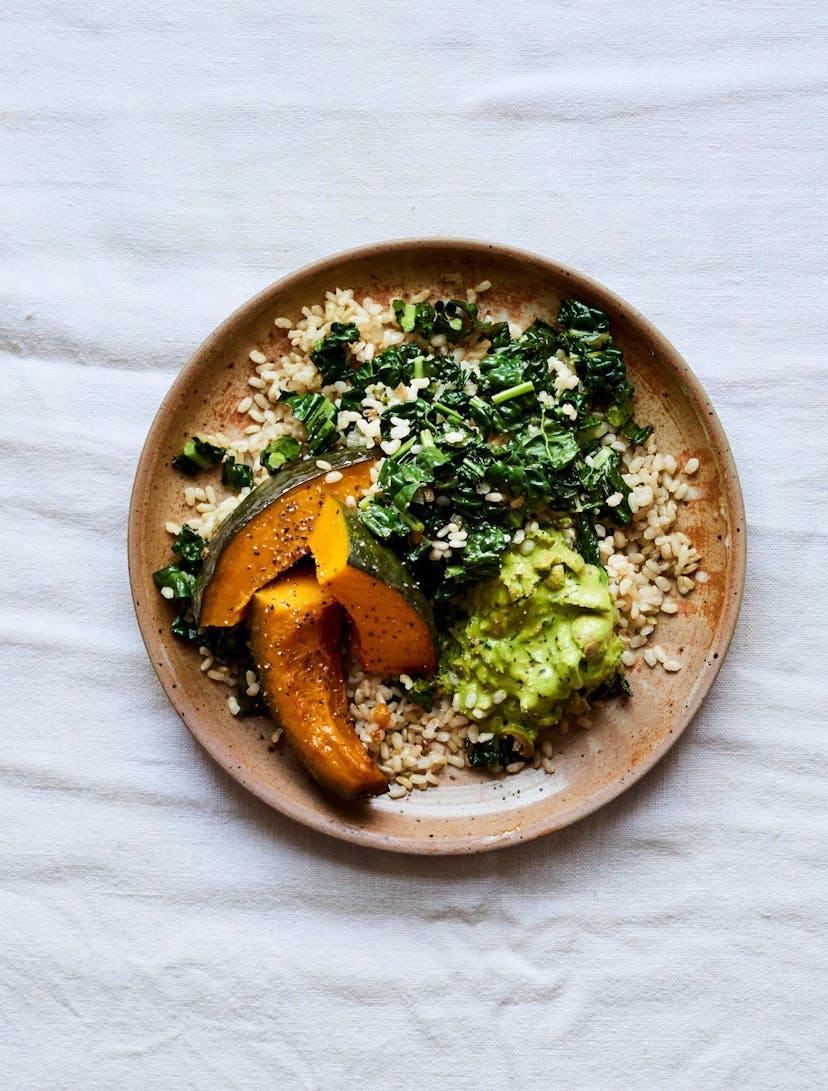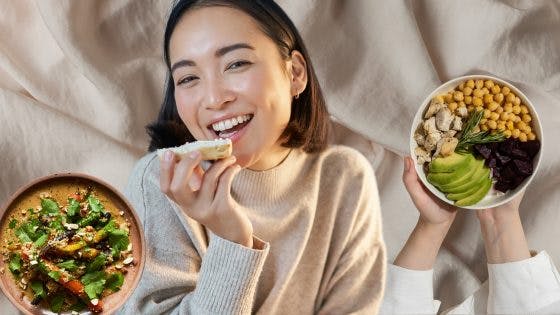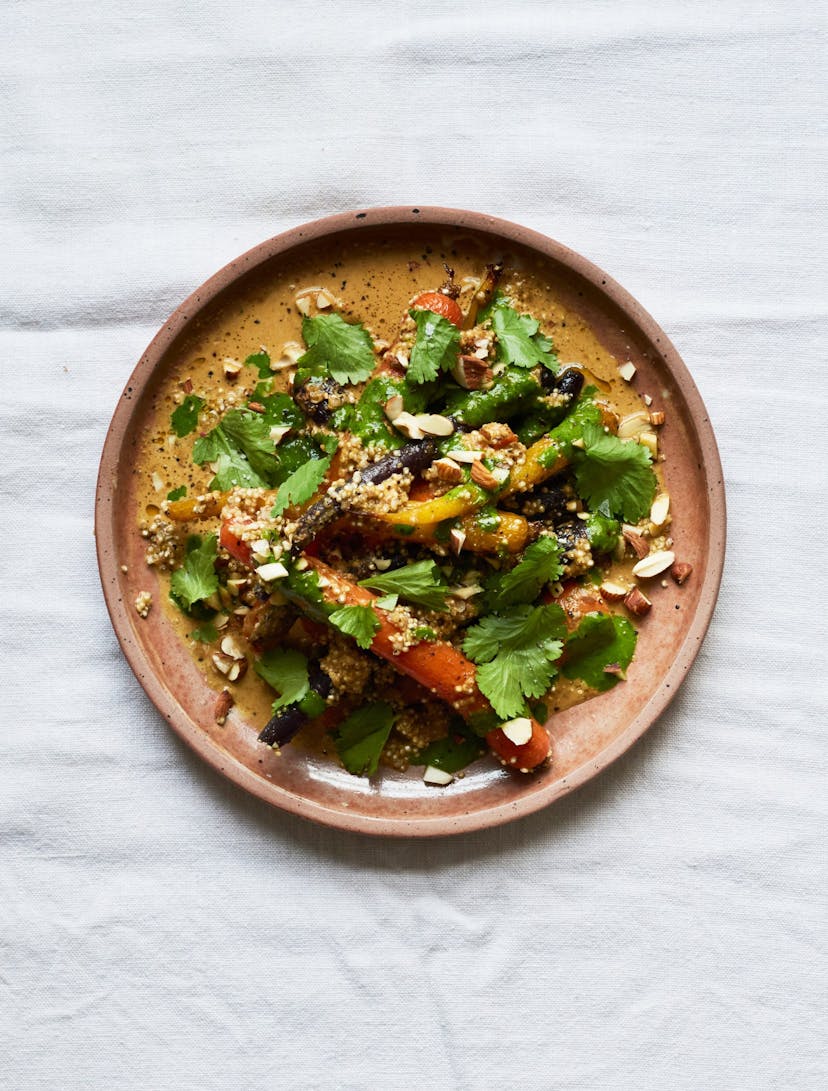Mood-Boosting Foods To Bring Joy In January
12 minutes read
Feeling a bit blue or lethargic lately? We’ve just got over Blue Monday, the alleged most ‘depressing day’ of the year, plus this whole month can be one big tiresome struggle. So if it’s affecting your mood negatively, consuming a diet packed with mood-boosting foods can help.
Beauty Daily asked leading nutritionists to explain how certain foods can boost your mood and what mood-boosting foods to add to your diet in January (and beyond). In addition, a top UK chef shares three easy mood-enhancing food recipes you can replicate at home.

How do the foods you eat affect your mood?
Food has a big impact on your overall mood. What you eat can determine how you feel first thing in the morning, right through how you sleep at night.
Ever noticed a sudden shift in mood when you eat something sweet and sugary? It makes you happy at first and then slumps and dampens your mood, quite the opposite of what you would be hoping for.
1. The sugar ripple effect
Natasha Alonzi, registered nutritional therapist and wellbeing coach explains that: “Once blood sugar is out of control, you can have symptoms such as anxiety, irritability, low mood, fatigue, and low energy.”
“This is because the body is designed to simultaneously have only one tsp of sugar in the blood. If there is more, the body will produce more insulin, lowering blood sugar and making you feel hungry, tired, and irritable.
As a result, you will find yourself in a pattern where you reach for a chocolate bar or a coffee, spiking your blood sugar again, and the rollercoaster continues all day right through to the night, where you find yourself waking up because of further dips in blood sugar,” Alonzi adds.
Whilst other factors can be at play and should be considered when looking at mental health, concentrating on mood-boosting foods, such as varied, whole food, can often make a difference in how we feel.
Nutritional psychiatry has been a growing field of interest over the last decade, and medical researchers continuously investigate how our diet affects mental health.
2. Consuming a Western diet
While no specific diet is best for mental health, some overall dietary choices are better than others.
It was concluded that the Standard American Diet (SAD diet), or so-called Western diet, contributes to a higher risk of depression than those who consume traditional diets such as the Mediterranean diet, with a 25-35% lower risk of experiencing depression.
Indeed, Western-type diets tend to be higher in processed foods, transfat and added sugar.
In contrast, traditional Mediterranean diets tend to be high in whole, unprocessed foods and significantly higher in fibre. Fibre is a key nutrient for your gut. The gut affects your mood.
Read next: Why You Need To Eat More Fibre: Simple Hacks To Up Your Intake At Home By A Doctor
“Following a Mediterranean-style diet can significantly improve mental health and have a beneficial effect on mood. A med-style diet typically includes lots of different coloured fruits and vegetables, with emphasis on whole grains, oily fish, nuts, and seeds, and includes moderate dairy and minimal red meat.
Overall, this diet pattern promotes the inclusion of lots of anti-inflammatory and antioxidant-rich foods, as poor mental health and depression can often be driven by underlying low-grade inflammation,” says Yasmin Alexander, BANT Registered Nutritionist.
3. Imbalanced gut activity
Eli Brecher, a registered associate nutritionist who specialises in gut health with a clinic based in Harley Street, says, “A great way to support our mood and overall mental health is by paying attention to our gut health, given that up to 95% of serotonin is produced in the gut. Serotonin (the happy hormone) is essential for maintaining mood balance and regulating sleep and appetite, and low serotonin levels have been linked with depression and anxiety.”

8 Nutritionist-approved mood-boosting foods to include in your grocery list
1. Avocado
Avocados are packed with mood-boosting antioxidants and nutrients to help support your brain health. It is also low in sugar to keep your blood sugar in check and your mood stable.
2. Leafy greens
“Leafy green vegetables such as broccoli, kale and cabbage are rich in magnesium and B vitamins which are proven to calm stress, improve mood, and reduce fatigue,” says Brecher.
3. Oily fish, nuts, and seeds
Alexander recommends consuming mood-boosting foods high in Omega 3 fatty acids as they are crucial for brain health, mental health and mood.
“They are mainly found in oily fish [aim to consume twice a week] such as salmon, mackerel, anchovies, sardines, and herring. However, smaller amounts can also be found in plant-based foods such as chia, flax, and walnuts,” says Alexander.
4. Protein
Protein helps boost serotonin and dopamine. These hormones influence our ability to feel happy, motivated, and relaxed. Alonzi recommends incorporating more mood-boosting foods, including seeds, nuts, eggs, plain natural yoghurt, kefir, and avocado at breakfast.
Munching on high-protein snacks can be beneficial instead of a bag of potato chips. Opt for almonds, walnuts, pumpkin seeds, or hummus. Make healthy dishes around chicken, fish, red meat, beans, pulses, and peas. These are great sources of protein.
5. Fermented foods
Making sure you support your gut with a diet high in fibre will give you a daily uplift in January and beyond. Also, load up on fermented mood-boosting foods such as sauerkraut, live yoghurt, and miso.
“These contain probiotic bacteria to support the gut-brain axis (the two-way communication pathway between the gut and the brain), which ensures your gut microbiome is happy, healthy and harmonious,” Brecher says. An imbalanced gut equates to anxiety, depression, lack of focus, and much more.
Read next: The Signs Your Gut Microbiome Is Out Of Balance And Ways To Fix It
6. Berries
Remember to have some mood-boosting berries. According to Stanford researchers, enjoying one cup of berries daily can make you feel 45% happier. This is thanks to its compound called anthocyanins, which push the brain to release the happy hormone serotonin.
7. Citrus fruits
Low vitamin C has been linked to high cortisol (stress hormone) levels. So experts recommend loading up your diet with vitamin C-rich foods. Kiwis, leafy greens, broccoli, Brussels sprouts, red and green peppers, oranges, and grapefruit are good sources.
8. Dark chocolate
For the sweet tooth, opting for dark chocolate instead of a bar of milk chocolate will benefit you better.
“Dark chocolates are high in antioxidants and magnesium, which can help lower stress levels,” says Brecher.
Read next: Here’s What Eating Too Much Sugar Does To Your Skin
3 Mood-Boosting Recipes by Top UK Chef Jackson Boxer

Detox Kitchen, UK’s leading healthy meal delivery service, has partnered with top chef Jackson Boxer to create three mood-boosting food recipes you can replicate at home or deliver to your doorstep. Luckily, Beauty Daily got a hold of the full recipes here. Happy cooking!
Delica squash and braised kale with green olive tapenade (Serves 4)

Mood-boosting food benefit: “Kale is packed with magnesium, which promotes serotonin. It is also a great source of iron. With a proper iron intake, you should see a boost in energy, which will complement your mood too,” says Lily Simpson, founder of Detox Kitchen.
Ingredients:
- 400g short-grain brown rice
- Delica Squash, cut into 90g wedges, deseeded.
- 50g white miso
- 50g apple cider vinegar
- 75g extra virgin olive oil
- 70g pine nuts
For the jalapeno oil:
- 100g jalapeno (deseeded save 1)
- 1 spring onion
- 200g neutral oil (rapeseed)
- 100g spinach
- 5g Maldon salt
For the braised kale:
- 1 shallot, chopped
- 100g shiitake, chopped
- 2 garlic cloves, minced
- 50g extra virgin olive oil
- Tsp Maldon salt
- 500g kale, sliced fine
- 1 orange, zest and juice
- 1 lemon, zest and juice
For the green olive salsa:
- 100g jalapeno oil
- 50g shallots, diced
- 50g chopped chives
- 50g minced green olive
- 4g ground white pepper
- 4g Maldon salt
Cooking method:
- Preheat your oven to 200 degrees Celsius.
- Make the jalapeno oil by blending all ingredients at high speed until smooth.
- Set aside; you’ll need this when you make the green olive salsa.
- Rinse the brown rice in cold water. Cover with one litre of cold fresh water in a pan, and bring up to a simmer. After a few minutes, when no longer crunchy but not yet soft, strain and rinse with cold water, and leave to cool and dry on a cloth-lined tray.
- Using a hand blender, blend the miso and vinegar together. Stream in the oil slowly to form a thick emulsion. Cover the squash wedges in the emulsion, then roast in the oven for 12 mins.
- Sweat shallot, shiitake, garlic, and chicory in extra virgin olive oil and salt, until softened but with no colour, around 30 mins.
- Add in the kale, and sauté for a few minutes until the kale is slightly wilted. Cool for a further 30 mins until totally soft.
- Add the citrus juice and zest and cook until the liquid has reduced to syrup.
- Make the green olive salsa by blitzing the jalapeno oil and all the other ingredients together in a blender until it forms a chunky mixture.
- Turn the oven down to 140 degrees Celsius and toast the pine nuts in an even layer for 30 mins. Serve by adding the brown rice and braised kale to a plate, top with the squash, followed by the tapenade, and lastly, the toasted pine nuts.
2. Beetroot soup with black beans and crispy shallots (Serves 4)

Mood-boosting food benefit: “Beetroot is a wonderful source of the chemical betaine. Betaine is produced naturally in our bodies, but a higher intake improves mood and boosts energy, as betaine can increase muscle endurance and accelerate muscle growth. What’s more, nitrates found in beetroot can strengthen the blood flow in your brain, positively impacting one’s mental health,” explains Simpson.
Ingredients:
For the ginger and turmeric oil:
- 50g ginger, peeled and chopped
- 5g garam masala
- 1.5g turmeric
- 1g salt
- 250ml veg oil
For the mushroom broth:
- 1L filtered water
- 50g dried mushroom
- 10g fennel seed
- 5g star anise
- 50g peeled ginger, sliced thin
- 2 cloves crushed garlic
- 50ml white soy
- 10g Dashi Powder
For the soup:
- 2 leeks, whites only, sliced fine
- 2 shallots, sliced fine
- 10g button mushroom, sliced fine
- 2 sticks celery, sliced fine
- 2 cloves garlic, sliced fine
- 50g extra virgin olive oil
- Tsp Maldon salt
- 2 large beets or 400g beetroot
- 2g coriander seed
- 2g cumin seed
- 2g smoked paprika
- 2g ground cinnamon
- 700g mushroom broth
For the black bean topping:
- 250g black beans, drained
- 50g red chilli, deseeded and brunoise
- 50g shallot brunoise
- 50g ginger, peeled and brunoise
- 50g chives, finely sliced
- 50g dill fronds, finely chopped
- 50g coriander stem, finely sliced
- 5g cumin, toasted and ground
- 5g ground black pepper
- 10g Maldon salt
- 1 lemon, zest of
- 50g crispy onions
Cooking method:
- Make the ginger and turmeric oil by adding all the ingredients listed to the thermo at full speed for 8 mins until smooth. Pour off and leave to cool gently. Ideally, rest overnight, but you can also use it once cool.
- Make the broth by adding all the ingredients listed to a pan and simmering for half an hour. Steep for 4 hours, till cool. Strain and gently press.
- Use a sharp mandolin to cut the shallots into 1mm rings, moving top to bottom. Submerge them in cold rapeseed oil in a pan and gently bring up the heat. As the oil heats, stir every few mins to avoid shallots clumping. Fry until the shallots turn a nut brown colour. Use a spider spatula to remove from the oil and put it on a towel-lined tray to dry. They will continue to darken to a golden colour. Store in an airtight container.
- Preheat the oven to 180 degrees Celsius. Wash the beetroot, rub with olive oil and sea salt, wrap in foil, and bake until the beetroot for 45-60 mins, depending on their size. Allow to cool; remove skins. Cut down into 3cm chunks.
- Sweat the leeks, shallots, mushrooms, celery, and garlic, in extra virgin olive oil and salt until softened but not coloured, around 30 mins.
- Add the beetroot and spices. Continue to cook for a further 5 mins or so. Add the celeriac and mushroom broth and bring up to a simmer. Blend to a smooth puree.
- Preheat the oven to 160 degrees. Strain the beans and hang them to remove water. Toss beans in extra virgin olive oil and toast in the oven for 15 mins. Allow to cool. Fold together with all remaining ingredients.
- Serve by adding the soup to a bowl, add the bean topping and finish with a sprinkling of crispy shallots.
3. Carrots with quinoa, mojo verde and hazelnut sauce (Serves 4)
Mood-boosting food benefit: “All nuts contain the amino acid tryptophan, which is proven to affect our cognitive health with mood-boosting and anxiety-reducing effects. Luckily this recipe is abundant in hazelnuts, which are also a great source of healthy fats,” shares Simpson
Ingredients:
- 200g quinoa
- 50g chopped almonds
For the carrots:
- 1kg carrots
- 10ml olive oil Maldon salt
- Cracked Black pepper
For the mojo verde:
- 15g cumin seed
- 5g cayenne
- 4 cloves garlic, crushed
- 3 bunch coriander, leaves 1 bunch chives, chopped 5g Maldon salt
- 50g sherry vinegar
- 150g extra virgin olive oil
For the hazelnut sauce:
- 1 shallot sliced
- 1 chilli seeded and sliced 10g ginger minced
- 2 cloves garlic, minced 15ml extra virgin olive oil 50ml gluten-free soy sauce 150ml coconut milk
- 20g honey or maple syrup 150g hazelnut butter
- 10g mild curry powder
Cooking method:
- Preheat the oven to 220 degrees Celsius.
- Place the carrots on a baking tray and toss in the oil, salt, and pepper. Roast in the oven until they are tender but still retain their bite.
- Cook the quinoa according to the instructions on the product’s label; you can tell it’s done when the seed separates from the germ. Drain and set aside.
- Make the mojo verde by blending the cumin, cayenne, garlic, coriander, chives,
- and vinegar into a thick paste. Dribble in the oil.
- To make the hazelnut sauce, sweat the shallot, chilli, ginger, and garlic in oil until softened. Add the soy and reduce it by half. Remove from heat, and add coconut milk, curry powder and honey. Transfer to a blender with nut butter. Pulse until smooth, then pass through a chinois.
- Serve by mixing the roasted carrots with the quinoa. Plate up, and then add a generous dollop of the mojo verde and hazelnut sauce drizzle. Finish with a sprinkling of chopped almonds.
If you want these delicious meals delivered to your doorstep, you can order them at Detox Kitchen. The dishes will be available across Fridge Fills, 3-Day Reset, and Meal Plans from the 4th of January, 2023. Visit their website for more mood-boosting meals freshly prepared and delivered to your door.
Read next: Liver Cleansing – How To Cleanse and Detoxify Your Liver
Sign up for our newsletter
We will keep you in the loop for special offers, exclusive gifts and product news.


